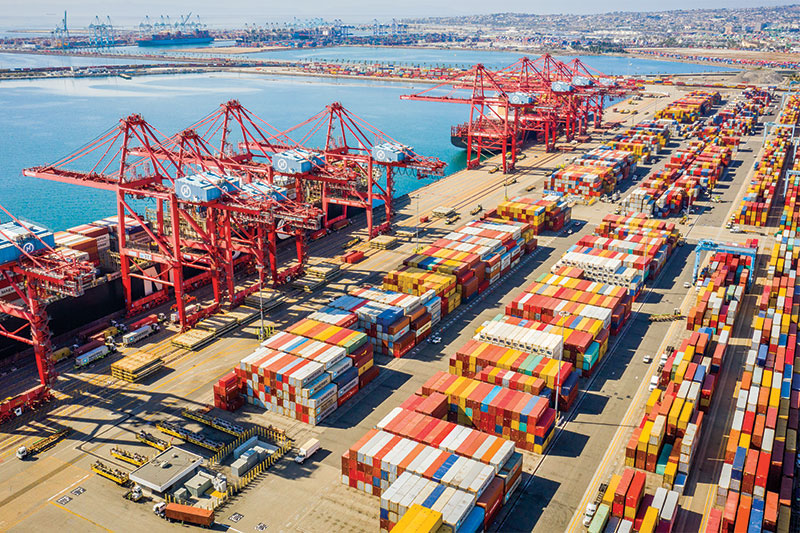Port Tracker report highlights new monthly import record

Following its previous report, which indicated United States-bound retail container import volumes were expected to approach near-record volumes against the backdrop of retailers striving to meet ongoing strong demand levels and also hedging against potential West Coast port labor disruptions, the new edition of the Port Tracker report, which was issued today by the National Retail Federation (NRF) and maritime consultancy Hackett Associates, heralded a new record for imports.
The ports surveyed in the report include: Los Angeles/Long Beach; Oakland; Tacoma; Seattle; Houston; New York/New Jersey; Hampton Roads; Charleston, and Savannah; Miami; Jacksonville; and Fort Lauderdale, Fla.-based Port Everglades.
Authors of the report explained that cargo import numbers do not correlate directly with retail sales or employment because they count only the number of cargo containers brought into the country, not the value of the merchandise inside them, adding that the amount of merchandise imported provides a rough barometer of retailers’ expectations.
“Cargo volume is expected to remain high as we head into the peak shipping season, and it is essential that all ports continue to operate with minimal disruption,” NRF Vice President for Supply Chain and Customs Policy Jonathan Gold said in a statement. “Supply chain challenges will continue throughout the remainder of the year, and it is particularly important that labor and management at West Coast ports remain at the bargaining table and reach an agreement.”
For May, the most recent month for which data is available, import volume—at 2.4 million TEU (Twenty-Foot Equivalent Units)—increased 6% compared to April and was up 2.7% annually. What’s more, this tally represents a new monthly import record, going back to when NRF initially began tracking imports, coming in ahead of the previous record, of 2.34 million TEU, set in March.
For the following months, Port Tracker issued the following projections:
- June, at 2.25 million TEU, up 4.8% annually, which would increase the first half 2022 total to 13.5 million TEU, for a 5.4% annual increase;
- July, at 2.31 million TEU, up 5.3% annually, which would be the fourth-busiest month on record;
- August, at 2.26 million TEU, down 0.5% annually;
- September, at 2.12 million TEU, down 0.8% annually;
- October, at 2.12 million TEU, down 4.1% annually; and
- November, at 2.06 million TEU, down 2.5% annually
The report’s authors explained that the annual projected declines, for the second half of 2022, “contrast with unusually high numbers during the same period in 2021,” while adding that volume levels are still high, with full year 2022 volumes remaining on course for a net annual increase.
Hackett Associates Founder Ben Hackett wrote in the report that congestion of ships waiting to berth at ports on the West Coast is easing, adding that there is an expectation to see the same on the East Coast, as carriers begin to return to their normal patterns of port calls.
“We continue to model the labor negotiations on the West Coast will conclude with a new contract and without any disruptions in the intervening period,” wrote Hackett. “Overall, our projection is for 2022 cargo imports to grow by 2.6 percent, driven by increased East Coast imports from Asia and Europe with larger ships. That is consistent with estimates that the ratio of container volume to GDP has slipped to just over 80 percent, which would equate to GDP growth of 2.1 percent in 2022.”

Article Topics
3PL News & Resources
FTR’s Trucking Conditions Index falls to lowest level since last September Cass Freight Index points to annual shipments and expenditures declines U.S.-bound import growth remains intact in April, reports Descartes Looking at a reshoring history lesson ISM May Semiannual Report points to growth in 2024, at a reduced rate April retail sales are mixed, reports Commerce and NRF LM Podcast Series: S&P Global Market Intelligence’s Rogers assesses 2024 import landscape More 3PLLatest in Logistics
FTR’s Trucking Conditions Index falls to lowest level since last September U.S. rail carload and intermodal volumes are mixed, for week ending May 11, reports AAR Cass Freight Index points to annual shipments and expenditures declines ALAN opens up its nominations for 2024 Humanitarian Logistics Awards U.S.-bound import growth remains intact in April, reports Descartes Looking at a reshoring history lesson NTSB: Ship lost power twice before slamming into Baltimore bridge, closing port More LogisticsAbout the Author
Subscribe to Logistics Management Magazine

Find out what the world's most innovative companies are doing to improve productivity in their plants and distribution centers.
Start your FREE subscription today.
May 2024 Logistics Management

Latest Resources














